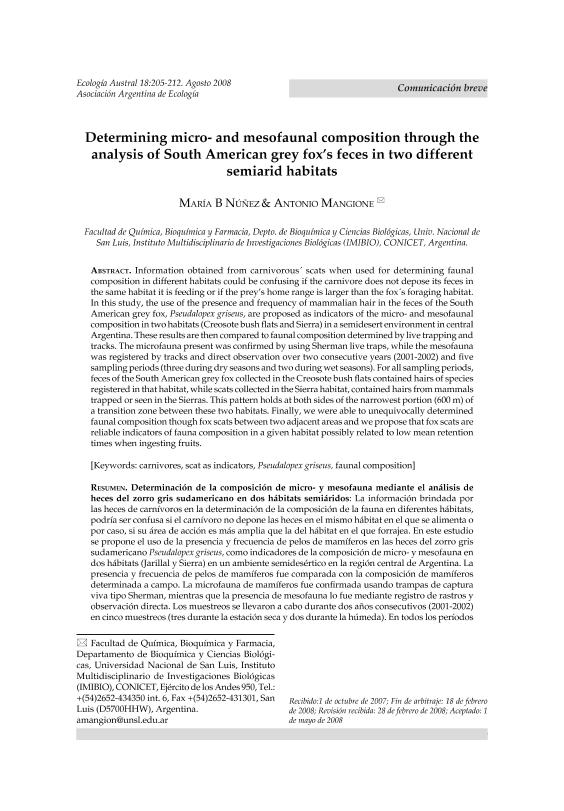Artículo
Determining micro- and mesofaunal composition through the analysis of South American grey fox’s feces in two different semiarid habitats
Fecha de publicación:
08/2008
Editorial:
Asociación Argentina de Ecología
Revista:
Ecología Austral
ISSN:
1667-782X
e-ISSN:
0327-5477
Idioma:
Inglés
Tipo de recurso:
Artículo publicado
Clasificación temática:
Resumen
Information obtained from carnivorous´ scats when used for determining faunal composition in different habitats could be confusing if the carnivore does not depose its feces in the same habitat it is feeding or if the prey’s home range is larger than the fox´s foraging habitat. In this study, the use of the presence and frequency of mammalian hair in the feces of the South American grey fox, Pseudalopex griseus, are proposed as indicators of the micro- and mesofaunal composition in two habitats (Creosote bush flats and Sierra) in a semidesert environment in central Argentina. These results are then compared to faunal composition determined by live trapping and tracks. The microfauna present was confirmed by using Sherman live traps, while the mesofauna was registered by tracks and direct observation over two consecutive years (2001-2002) and five sampling periods (three during dry seasons and two during wet seasons). For all sampling periods, feces of the South American grey fox collected in the Creosote bush flats contained hairs of species registered in that habitat, while scats collected in the Sierra habitat, contained hairs from mammals trapped or seen in the Sierras. This pattern holds at both sides of the narrowest portion (600 m) of a transition zone between these two habitats. Finally, we were able to unequivocally determined faunal composition though fox scats between two adjacent areas and we propose that fox scats are reliable indicators of fauna composition in a given habitat possibly related to low mean retention times when ingesting fruits.
Palabras clave:
CARNIVORES
,
SCAT AS INDICATORS
,
PSEUDOLAPEX GRISEUS
,
FAUNAL COMPOSITION
Archivos asociados
Licencia
Identificadores
Colecciones
Articulos(IMIBIO-SL)
Articulos de INST. MULTIDICIPLINARIO DE INV. BIO. DE SAN LUIS
Articulos de INST. MULTIDICIPLINARIO DE INV. BIO. DE SAN LUIS
Citación
Nuñez, Maria Beatriz; Mangione, Antonio Marcelo; Determining micro- and mesofaunal composition through the analysis of South American grey fox’s feces in two different semiarid habitats; Asociación Argentina de Ecología; Ecología Austral; 18; 2; 8-2008; 205-212
Compartir




